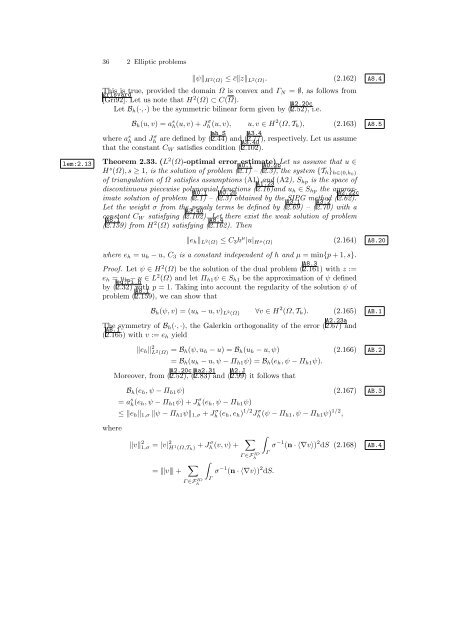2 DGM for elliptic problems
2 DGM for elliptic problems
2 DGM for elliptic problems
Create successful ePaper yourself
Turn your PDF publications into a flip-book with our unique Google optimized e-Paper software.
36 2 Elliptic <strong>problems</strong><br />
‖ψ‖ H 2 (Ω) ≤ ¯c‖z‖ L 2 (Ω). (2.162) A8.4<br />
This is true, provided the domain Ω is convex and Γ N = ∅, as follows from<br />
grisvard<br />
[Gri92]. Let us note that H 2 (Ω) ⊂ C(Ω).<br />
Let B h (·, ·) be the symmetric bilinear <strong>for</strong>m given by ( 2.52), A2.20c i.e.<br />
lem:2.13<br />
B h (u,v) = a s h(u,v) + Jh σ (u,v), u,v ∈ H 2 (Ω, T h ), (2.163) A8.5<br />
where a s h and Jσ h<br />
are defined by (ah_S 2.44) and ( 2.77), A3.4 respectively. Let us assume<br />
that the constant C W satisfies condition ( 2.102).<br />
A3.40<br />
Theorem 2.33. (L 2 (Ω)-optimal error estimate) Let us assume that u ∈<br />
H s (Ω),s ≥ 1, is the solution of problem ( 2.1) A0.1 – ( 2.3), A0.2b the system {T h } h∈(0,h0)<br />
of triangulation of Ω satisfies assumptions (A1) and (A2), S hp is the space of<br />
discontinuous piecewise polynomial functions ( 2.16)and A1.23 u h ∈ S hp the approximate<br />
solution of problem ( 2.1) A0.1 – ( 2.3) A0.2b obtained by the SIPG method ( 2.62).<br />
A2.22c<br />
Let the weight σ from the penaly terms be defined by ( 2.69) A3.1 – ( 2.70) A3.2 with a<br />
constant C W satisfying ( 2.102). A3.40 Let there exist the weak solution of problem<br />
( 2.159) A8.1 from H 2 (Ω) satisfying ( 2.162). A8.4 Then<br />
‖e h ‖ L 2 (Ω) ≤ C 3 h µ |u| H µ (Ω) (2.164) A8.20<br />
where e h = u h − u, C 3 is a constant independent of h and µ = min{p + 1,s}.<br />
Proof. Let ψ ∈ H 2 (Ω) be the solution of the dual problem ( 2.161) A8.3 with z :=<br />
e h = u h − u ∈ L 2 (Ω) and let Π h1 ψ ∈ S h1 be the approximation of ψ defined<br />
by ( 2.32) eq:Pi_h with p = 1. Taking into account the regularity of the solution ψ of<br />
problem ( 2.159), A8.1 we can show that<br />
B h (ψ,v) = (u h − u,v) L2 (Ω) ∀v ∈ H 2 (Ω, T h ). (2.165) AB.1<br />
The symmetry of B h (·, ·), the Galerkin orthogonality of the error ( 2.67) A2.23a and<br />
( 2.165) AB.1 with v := e h yield<br />
‖e h ‖ 2 L 2 (Ω) = B h(ψ,u h − u) = B h (u h − u,ψ) (2.166) AB.2<br />
= B h (u h − u,ψ − Π h1 ψ) = B h (e h ,ψ − Π h1 ψ).<br />
Moreover, from ( 2.52), A2.20c ( 2.83) Aa2.31 and ( 2.99) A2.J it follows that<br />
B h (e h ,ψ − Π h1 ψ) (2.167) AB.3<br />
= a s h(e h ,ψ − Π h1 ψ) + J σ h(e h ,ψ − Π h1 ψ)<br />
≤ ‖e h ‖ 1,σ ‖ψ − Π h1 ψ‖ 1,σ + J σ h(e h ,e h ) 1/2 J σ h(ψ − Π h1 ,ψ − Π h1 ψ) 1/2 ,<br />
where<br />
‖v‖ 2 1,σ = |v| 2 H 1 (Ω,T h ) + Jσ h (v,v) + ∑<br />
= |||v||| + ∑<br />
Γ ∈F ID<br />
h<br />
∫<br />
Γ<br />
Γ ∈F ID<br />
h<br />
∫<br />
Γ<br />
σ −1 (n · 〈∇v〉) 2 dS.<br />
σ −1 (n · 〈∇v〉) 2 dS (2.168)<br />
AB.4
















